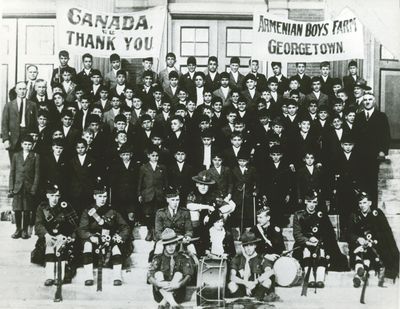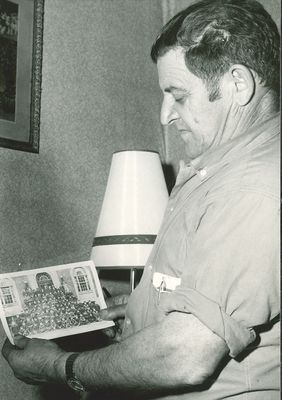

The Turkish genocide and deportation of the Armenian people took place between 1915 and 1923. During this time, many children were separated from their families or became orphans when they were forced out of Turkey. Refugees were taken to camps, such as the one in Corfu, Greece, where most of the Georgetown Boys would eventually come from.
Relief committees sprang up all over the world as countries such as the United Kingdom, France and Canada began to send money and staff to support the refugee camps in Greece and Egypt. The Lord Mayor’s Armenian Fund of London, England (also known as the Lord Mayor’s Fund) was created in 1916 to help with the resettlement of Armenian War refugees. The Near East Relief was an American organization that provided aid to “Near East” countries and displaced refugees and was involved in supporting Armenian refugees during this time.
Canadians interested in providing aid to Armenian refugees would have first been involved in the Lord Mayor’s Fund. Then, around 1921 or 1922, the Armenian Relief Fund of Canada began rallying support as well. As the organization grew and more clear objectives were proposed, the organization became known as the Armenian Relief Association of Canada.
It was this group, with the help of the Lord Mayor’s Fund, that arranged to bring orphaned Armenian boys to Georgetown, Ontario.
After much consideration, planning and selection, the first group of 50 boys living in the Lord Mayor’s Fund orphanage in Corfu boarded the steamship S.S. Minnedosa for their voyage to Canada. They arrived in Georgetown on July 1, 1923.
Over a year later, a second group of 40 boys left Corfu on the S.S. Braga and arrived in Canada on September 30, 1924. A third group of 8 boys came from Shemlan, Lebanon and arrived on August 1, 1926. A final and fourth group of 11 also arrived from Lebanon on July 27, 1927.
Cedarvale Farm, located on Highway 7, had been purchased by the Armenian Relief Association and became the boys’ home in Georgetown.
The boys were all between eight and fifteen years old when they first arrived in Canada. None of them spoke English and the Cedarvale staff didn’t speak Armenian, making communication sparse. Eventually, a bilingual teacher, Aris Alexanian, was brought from Hamilton to teach the boys.
The boys were all assigned numbers by which they were identified for activities and their daily chores. Even once their farm days were long behind them, their assigned numbers would stick with them. One of the boys, Paul Adourian, said in a Toronto Star interview that, “I got so used to knowing the boys by their numbers that to this day I can identify them more quickly and accurately by their number than by their name.”
While living at Cedarvale, the boys’ duties included serving tables, washing dishes, peeling vegetables, cleaning and performing other chores, as well as milking the farm’s cows, feeding the pigs, looking after the poultry and horses, and chopping wood.

Their chores and education at Cedarvale were meant to prepare them for when they aged out of the farm and would go work for farmers across Ontario. By 1925, the eldest boys began to be placed in farm homes. Although the expectation was that the boys would work and continue to attend school, it was often at the farmer’s discretion and education was not always a priority.
By 1928, all of the boys had been placed in farms around Ontario and the Armenian Relief Association sold Cedarvale Farm to the United Church to become the Cedarvale School for Girls. The administration and legal affairs of the Georgetown Boys was also taken over by the United Church at this time.
Despite entering Canadian society during the Depression in the 1930s, many of the boys kept in touch and lived successful lives. Some went to the US and others moved overseas, while others remained in the Greater Toronto Area. About 25 of them joined the armed forces during World War II.
Although grown up and with families of their own, whenever they reunited in Georgetown for picnics, they were – and still are – affectionately referred to as the Georgetown Boys.
